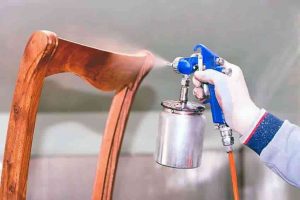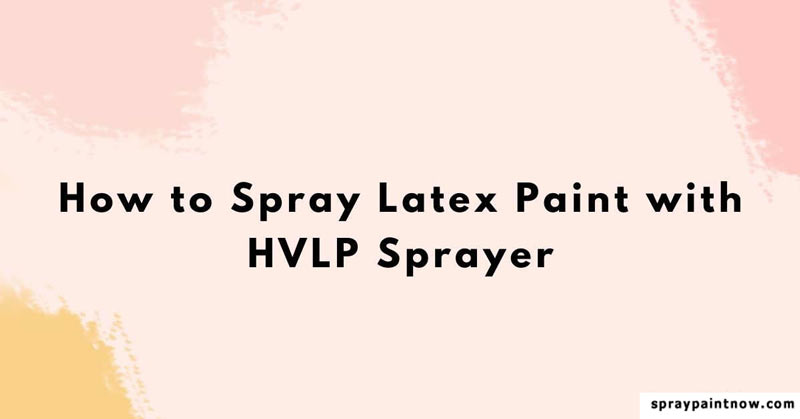Owning the best hvlp sprayer for latex paint isn’t going to ensure a smooth and even paint finish. Latex spraying itself is a complex and challenging job due to its thick viscosity. Though an HVLP spray gun is a good option for indoor improvement and DIY projects, they are not the ideal paint gun to apply latex paint.
Having said that, you can still use it for this purpose only if you know the tricks about how to spray latex paint with hvlp paint gun. Here, through this article, I will inform you all about the HVLP sprayer mechanism and the detailed process of spraying latex paint with hvlp sprayer.
So, stay tuned to learn more!
What Is an HVLP Paint Sprayer?
Before you spray latex with hvlp paint sprayer, it would be a wise decision to learn the mechanism of this gun. HVLP or high volume low pressure paint guns use low pressure to atomize paint in a way that minimizes the chance of overspray. Due to this factor, they work well with most oil-based paints.
Since latex paints are water-based solutions, they are way too thicker to pass through the passage smoothly. Thus, the paint has the tendency to clog the nozzle. Hence, for spraying latex paint with hvlp paint sprayer, you need to prepare the paint beforehand. Moreover, it would be best if you had some additional accessories and equipment to overcome the obstacles.

How to Spray Latex Paint with HVLP Sprayer?
As you already know, the HVLP paint guns work efficiently with oil-based paints. However, the latex paints are water-based; thus, they are too thick to spray with low pressure. Don’t worry! You can still ensure compatibility of hvlp sprayers for latex paint if you follow the below instructions carefully. Though it takes a little bit of effort, you can still be successful at painting with such thick viscosity of latex.
Preparing the Paint
To apply latex with HVLP paint gun, you need to thin out the paint first. In that case, the ratio of the thinner and paint must be correct so that it doesn’t become too thin. Otherwise, it will impact the outcome as well as drying time.
You can thin out the paint with thinner or normal room temperature water. Then, to know how much water to add to the paint, you need to refer to the brand instruction and the paint quality. Usually, you should start with 10% of water and mix it thoroughly with the paint. Then, add more water, gradually checking the thickness. Here, remember not to add water more than 25%. If the paint is too thin, then it won’t bring a smooth and even coverage.
Use Additives
After using thinner or water, if the paint is not thin enough to use it with an HVLP gun, it’s better to use additives. The additives are actually a paint conditioner that helps to reduce the paint viscosity. Moreover, they also facilitate the paint to flow freely and ensure better coverage without adding any thinner. Remember to use additives when you should use additives when you need to add more water to dilute the paint. Start with 8 oz. of additives to 1 gallon of latex. You should use more than 32 oz. of conditioner per gallon.
Straining
After preparing the paint with a thin consistency, you need to stain it to remove any impurities such as chunks, dust, dirt, etc. Since the HVLP paint nozzle is very tiny, like 1.4mm, the paint can easily clog the tip if inserted without straining. Then, it will be very difficult to clean the gun. Hence, filtering the paint is a crucial step that you must follow.
Hose Length
In case you don’t know, while spraying latex paint with compressed air, the hose length leaves an impact on the painting outcome. The HVLP paint gun works with a turbine motor. If the hose length is short, then the gun would create heat that will directly feed to the paint. As a result, the paint drying time will get reduced and subsequently impact the coverage. Therefore, it’s better to use at least a 6 ft. long hose so that the turbine can reduce the temperature while atomizing the paint.
Test Spraying
As the gun is loaded with paint and you have the long hose, it’s time to test the spray paint. At this stage, you should choose a cardboard surface or scrap board. Then, the best way to spray latex paint is by holding the gun at a distance of about 8 inches from the surface. If the surface is vertical, then start from the top. Otherwise, for a horizontal surface, start from one edge and move to the opposite side. Keep spraying thoroughly until one section is completely wet.
Final Thought
To wrap up, painting is all about practice and techniques. A bit of basic knowledge and practice can help you understand the characteristics of thick paint like latex. Then, you can easily understand how much thinner or additives to add in order to prepare the paint to use it with the HVLP gun. Initially, you may struggle to bring the right viscosity and deal with blobs and uneven finishes. Don’t worry!
Now you know how to spray latex paint with HVLP paint gun. Just follow the above-mentioned steps with patience and concentration, then you can become a pro painter in no time.
